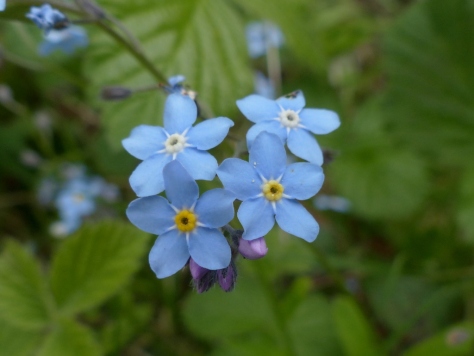 There is very little point in holding on to the past. What is gone is gone.
There is very little point in holding on to the past. What is gone is gone.
Today I am in the best place that I have ever been in my life. It is completely peaceful here, full of birdsong and the scent and colour of wildflowers. I am letting go of all that used to be, that was hard work 🙂
So my overly sweet and pretty little friend, you are a Wood Forget-me-do.
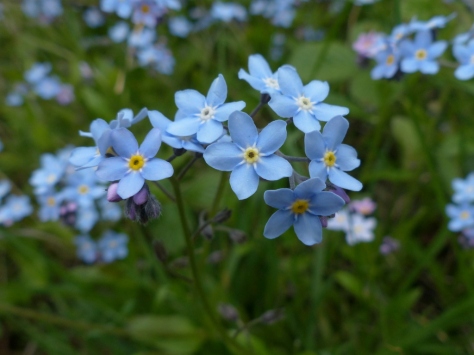 It is not always easy to get Forget-me-do’s to species, the Wood Forget-me-do is very similar to the field variety.
It is not always easy to get Forget-me-do’s to species, the Wood Forget-me-do is very similar to the field variety.
 A British pound coin has a diameter of 22.5 mm (about the size of a wedding ring, I guess)These flowers look about 7-8 mm across. (Three to the pound) Field Forget-me-do’s are about half that size 3-4 mm. These flowers are also quite flat.
A British pound coin has a diameter of 22.5 mm (about the size of a wedding ring, I guess)These flowers look about 7-8 mm across. (Three to the pound) Field Forget-me-do’s are about half that size 3-4 mm. These flowers are also quite flat.
The shape of the calyx pushes the petals of the Field flower up making more of a cup shape out of it.
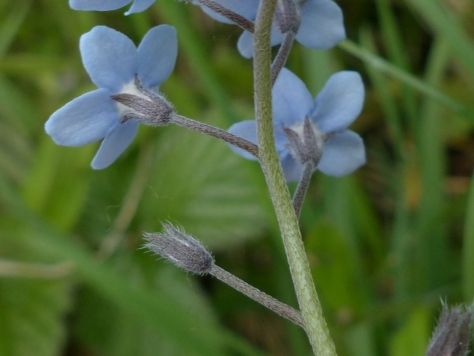 The calyx of the field variety is almost bell shape with the tips of the sepals closing to a point. The wood variety is more linear with an open end.
The calyx of the field variety is almost bell shape with the tips of the sepals closing to a point. The wood variety is more linear with an open end.
In both cases the individual flower stalks are about twice the length of the calyx. That pedicle length is key to separating some of the smaller species and so it should be noted.
 Locally it is in flower now and you can see it in all the more open hedgerows as you walk into the village (dodging the devilish little lambs).
Locally it is in flower now and you can see it in all the more open hedgerows as you walk into the village (dodging the devilish little lambs).
The large flower of the Wood Forget-me-do is the source of most of the garden varieties.
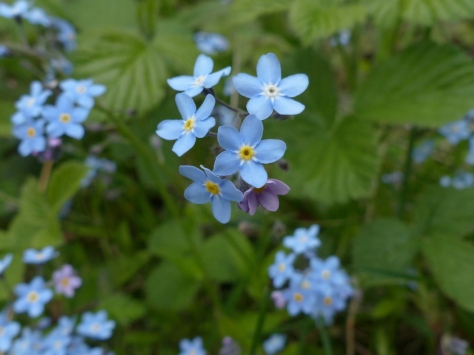 Goodbye whatever your name was, I am afraid that it has gone again. I do remember that you were a very pretty little flower.
Goodbye whatever your name was, I am afraid that it has gone again. I do remember that you were a very pretty little flower.

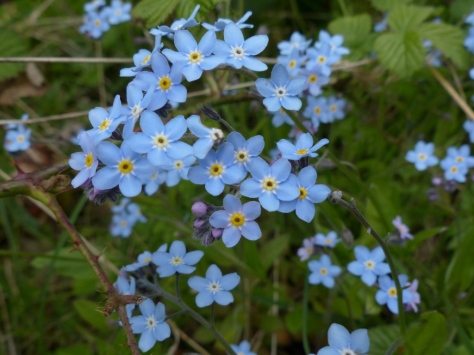
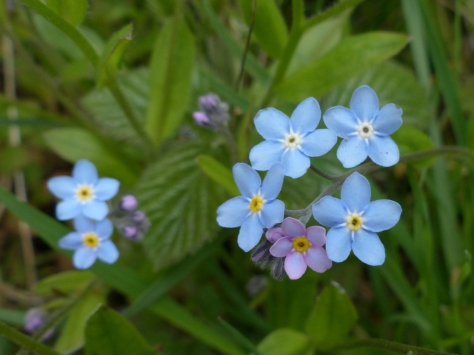
How often I have found since following your blog the the tiny little flowers I used to walk over are such pretty little things.
LikeLiked by 3 people
Thank you John 🙂 There are so many little flowers here that not stepping on them is causing me major problems 🙂
LikeLike
A beautiful flower to compare with new beginnings and letting go. Thank you for share.
LikeLiked by 1 person
Thank you 🙂
LikeLike
Have peace and be well.
LikeLiked by 1 person
Thank you Sarasin 🙂 I spent a long time with my therapist yesterday and she said that, ” as long as the grass doesn’t get so long that we can’t find the ball, everything will be fine.” She is good.
LikeLiked by 1 person
Such a good therapist. 🙂
LikeLiked by 1 person
They are beautiful little flowers, of a wonderful shade of blue.
LikeLiked by 1 person
Thank you John 🙂 I am finding it just a little bit tricky to separate the species but it will be worth the effort.
LikeLike
Nature brings happiness and peace. Did you know that the yellow centres of this little whatya-call-it flower indicate that nectar is available, then the centres fade to white after the flower has been pollinated so that bees don’t waste their time visiting it.
LikeLiked by 2 people
Thank you Emily 🙂 I hadn’t heard that but it sounds great. I had assumed that the pollen was yellow and when it was spent the anthers were white. That is very interesting because to avoid self fertilisation I would expect the flower to want to attract bees after it’s own pollen was spent. I will investigate that because there is often good reason behind these stories.
LikeLike
Here’s the reference for it, I learnt about it while studying for a beekeeping exam – http://blog.mbbka.org.uk/category/education/bbka-module-2/ – see the top pdf, p.47.
There are also lots of other flowers that change colour or shape after fertilisation, as the pdf explains, horse chestnut is another that changes colour and in clover the florets drop after pollination.
See also this great post on pulmonaria (lungwort), Philip explains that “the colour change is a signal to pollinators. The pink colour tells pollinators that the flower has plenty of nectar whereas the blue says “don’t bother”. Hence pollinators don’t waste time visiting low-nectar blooms and they may visit several plants looking for high nectar flowers increasing the chance of cross pollination. ” https://philipstrange.wordpress.com/2015/04/10/loitering-by-lungwort-peering-at-pulmonaria/
LikeLiked by 1 person
Thank you Emily 🙂 This is something that I am really interested in and need to find out a bit more about. I am aware of the effect of authocyanidins that cause a colour change in leaves and petals and that in some flowers this indicates that the flower has aged and is beyond fertilisation. I keep seeing this information applied to Forget-me-nots and I am sure that this is misinformation. Forget-me-nots emerge from the bud pink but turn blue almost immediately, too quickly for it to be a sign that the flower is aged. People regularly post things on the internet and then others repeat it and misinformation spreads like wildfire but I trust my own eyes. That is information regarding colour change in petals and is not the same as your own account of the fornice ring changing colour to tell bees that the flowers are no longer worth visiting.
I can not trace any scientific account of a chemical change in the fornice ring of Myosotis and I am searching Google Scholar. That just means that I haven’t found what I am looking for yet. but.. Another possible explanation for the change goes back to the pollen. The pollen of Forget-me-nots is bright yellow and would display on the fornice ring. Once the pollen was spent the ring might turn white and that would indicate to bees that there was no more pollen and the flower was not worth visiting.
It is something that I would like to understand and I am still digging, so thank you Emily 🙂
LikeLiked by 1 person
Very pretty. I learn so much when I stop by over here. Thanks.
LikeLiked by 1 person
Thank you Dan 🙂
LikeLike
Amazing coincidence. I found a FMN in the garden yesterday and I was struggling to get it to species level. I hadn’t appreciated how many there are. I’m still not 100% sure. I was distracted by moths this morning and I must go back to it. Very useful post. Thanks Colin.
LikeLiked by 1 person
Thank you Andrew 🙂 It is a difficult subject. I had to go to the experts and found that I had initially got it wrong. The defining feature turned out to be the patent hairs on the lower part of the stem.
Patent as opposed to adpressed (sticking out and not lying flat. I don’t know why botanists have to invent words when we already have perfectly good ones. That frustrates me)
They gave me a link to this video key.
It is not as easy as it ought to be 🙂
LikeLike
Hmmm. Well according to the key it ought to be Creeping Forget-me-not, Colin. But when I read my book, Harrap, it is closer to Water Forget-me-not. I think the flowers are too dark for Creeping. BAsed on the hairs on the stem it is not Wood FMN. I remain confused :-))
LikeLiked by 1 person
I love them because of their name. My hubby and I had a long distance relationship. When he picked a forget-me-not and gave it to me before he left… aww… it’s my favorite flower since then haha 😀
LikeLiked by 2 people
Thank you Becky 🙂 It is a lovely little flower.
LikeLiked by 1 person
The blue are a favorite flower. I have pictures of Sagebrush and Mountain bluebells . Of course different species.
LikeLiked by 1 person
Thank you Bettylouise 🙂 I love to see the little splashes of blue in the field when everything else seems to be yellow. There is quite a lot of pink coming up now though 🙂
LikeLiked by 1 person
I’m so very, very happy for you. And the flowers are beautiful.
LikeLiked by 1 person
Thank you Gigi 🙂
LikeLike
I’ve forgotten what I was going to comment …. 😉
LikeLiked by 1 person
Thank you RR 🙂 and there are still some youngsters out there who think that memory loss is a bad thing 🙂
LikeLike
I like your twist of name, suits the moving on. I know there are several species and many using the common name are not Myosotis, though I haven’t made as close a study as you. I have the spring blooming wooly M. sylvatica self-sowing madly in the garden, but my favorite is the smooth M. scorpiodes that grows near the streams and blooms in midsummer. It is considered invasive, but that is not my experience here. There are far worse interlopers like knotweed, honeysuckle and multiflora rose.
LikeLiked by 1 person
Thank you Eliza 🙂 Agreed, it is a small and attractive flower and it doesn’t really overshadow anything. It can’t be that invasive.
LikeLiked by 1 person
I am having trouble with the names, but the flowers are lovely.
May your day go well.
LikeLiked by 1 person
Thank you Ettel 🙂 I read somewhere that it is not really important to know what species it is, just to know that the pretty ones are called Forget-me-nots 🙂
LikeLike
Beautiful photos of lovely forget-me-dos. This post will be very useful to me as I find telling the difference between them all so difficult.
Letting go of the past and accepting the present is so hard to do when you have suffered as you have done. Once done it is like the sun coming out from behind a cloud.
LikeLiked by 1 person
Thank you Clare 🙂 The video key that I posted in an earlier comment for Andrew is actually quite good if you can get around the jargon. I would like to find a way to make it easier.
It all has to do with the flower’s hairy legs.
The sun is shining this morning and our only concern is where to walk today. Life couldn’t be kinder 🙂
LikeLiked by 1 person
I hope you had a lovely day 🙂
LikeLiked by 1 person
Sweet lovely little things…
LikeLiked by 1 person
Thank you Julie 🙂
LikeLike